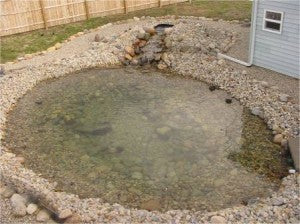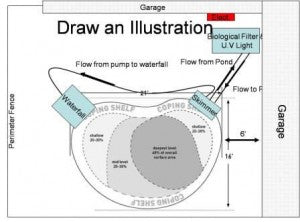Are you considering the addition of a pond at your home? The key to a successful and healthy pond involves thorough planning. Take the time to read many articles and talk pond owners to get a better understanding of all that is involved.
Use this article to become acclimated with some of the basic information pertaining to planning your own pond. It can be an extremely rewarding hobby.
What Type of Pond Do You Want
More specifically, what type of aquatic life do you plan to have inhabiting your pond? This is a crucial first step in the planning process because the requirements are vastly different for a koi pond versus a goldfish pond versus a simple water garden. For example, a healthy koi pond requires a larger, deeper pond with preferably a bottom drain for better filtration as opposed to a goldfish pond.
Design on the Size and Shape of your pond
Creativity is all yours when it comes to the shape of your pond. Keep in mind that it is important to have good water flow throughout the pond. So avoiding square corners that will trap dirt and create stagnant, non-moving areas would be ideal. For example, keeping a waterfall on the opposite side of the pond across from the skimmer box would provide good water flow.
If you are considering a koi pond, most koi enthusiasts recommend a minimum size of 1000 gallons and at least 3 feet deep, and a depth of up to 6 feet is even more desired. This depth is important to help keep koi safe from their natural predators, raccoons and heron. It also helps to adjust for temperature fluctuations in colder winter climates.
Consider the incorporation of ledges or shelves in your pond to place plants, by digging a shelf around the inside perimeter of the pond.
Determine the Location
There are several important factors that you should consider to help determine your pond location.
Safety- Water is a natural attraction for children; therefore, it’s extremely important to reduce the chance of unsupervised children gaining access to the pond. One simple solution is to build it inside a fenced area.
Sunlight Requirements- Certain water plants, such as water lilies, require at least 4-6 hours of sunlight daily. Most koi enthusiasts won’t put water plants in the pond because koi do typically eat the plants. But keep in mind that water lilies are an excellent way to shade your pond and add some definite beauty. This shading also helps to control algae, as well as, control the water temperature. Your pond should not be placed under a tree where leaves and debris can be allowed to drop into the pond. As leaves decompose, they produce toxins that are toxic for your fish. A good sun-shade balance should be maintained.
Buried Utilities- Always call all utility companies before digging to assure no buried cable lines, gas and phone lines, etc. will interfere with your future pond site.
Electrical Requirements- A healthy pond will need an electrical source close to run, at minimum, a pump which will circulate the water through filtering devices.
Elevation of the Land- The pond surface level should always be higher than the surrounding area to avoid water runoff into the pond. Runoff from fertilized yards, farm fields and rooftops shouldn’t be allowed to flow into the pond. Building a lip around the perimeter of the pond will deter this water runoff.
Determine the pond equipment needed
Pump: The pump is a vital part of any pond. It is responsible for circulating water throughout the pond and the filters. While doing this, it also provides critically-needed oxygen to the fish in the pond. Some ponds have more than one pump, one for each filtering method.
Filters: There are two types of filtration, biological and mechanical. They both filter the water in 2 completely separate ways.
Biological Filter- This filtration method uses beneficial bacteria to detoxify the organic waste present in your pond. The filter medium in the “bio” filter provides surface areas for these beneficial bacteria to grow. The detoxification process occurs as the water is filtered past the filter medium. Commercial bio filter units are available, while others make their own using filter medium such as lava rocks. There is much debate on using lava rock for this purpose though. So, always make an informed decision based off of a well researched plan that fits your needs.
Mechanical Filter- This filtration method physically traps dirt and debris as the water passes through the filter. The filter medium is usually in the form of net, foam, mesh, brushes or even a screen-like material.
Skimmers- Skimmers do just that, they skim floating dirt and debris off the water surface. Skimmers are becoming deemed more as a necessity than in previous times. These skimmers also offer a hiding place for your pumps, as they are designed to incorporate the pumps in the base of them.
Ultra-violet Clarifier- UV lighting, commonly used in koi ponds, is used to aid in algae control. The microscopic algae-mixed water passing through ultra-violet light will die. These lights will only kill existing algae cells, not prevent new from forming. So if conditions are right for algae to produce, it will. Understanding how to maintain an algae free pond will help to assure that the UV clarifier works at its best. While there are skeptics that say this type of lighting shouldn’t be necessary, you will have to make that decision based off of your own research and needs.
Pond Liner- One common way of retaining water in your pond is to use a pond liner made of a material known as EPDM. Liners will be measured based on their thickness, common thicknesses of either a 45 or 60 mil are desired for this application. While some pond owners choose a more permanent bottom on their pond made of concrete, the average pond owner will have great success with an EPDM liner.
Draw an Illustration
Take the time to draw out and illustration, showing all electrical needs, dimensions, surrounding buildings, etc. Get an idea if it is truly going to work.
Lastly
Still overwhelmed? Consider hiring a professional to design the pond only. Take this design and build it yourself, if you feel qualified. Some professionals will also charge a nominal fee to oversee your project at different steps in the build as you need them. This can save you a great deal of money, yet give you a well designed pond.
While this article just skims the surface on the proper planning of building a successful pond, it should give you a better understanding of the proper planning needed. As I stated earlier, it is a very rewarding hobby!




